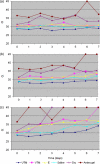Evaluation of swabs, transport media, and specimen transport conditions for optimal detection of viruses by PCR
- PMID: 22205810
- PMCID: PMC3295134
- DOI: 10.1128/JCM.06551-11
Evaluation of swabs, transport media, and specimen transport conditions for optimal detection of viruses by PCR
Abstract
Depletion of swabs and viral transport medium during epidemics may prompt the use of unvalidated alternatives. Swabs collected and transported dry or in saline were compared to commercially available swab/medium combinations for PCR detection of influenza, enterovirus, herpes simplex virus, and adenovirus. Each was detected at an ambient temperature (22°C) and 4°C for 7 days. Detection of influenza on dry or saline swabs is important because of its capacity to cause outbreaks involving large numbers of cases.
Figures
References
-
- Ding DC, Chang YC, Liu HW, Chu TY. 2011. Long-term persistence of human papillomavirus in environments. Gynecol. Oncol. 121:148–151 - PubMed
-
- Druce J. 2001. Human immunodeficiency virus: disinfection and control, p 573–584 In Block SS. (ed), Disinfection, sterilization, and preservation, 5th ed Lippincott Williams & Wilkins, Philadelphia, PA
Publication types
MeSH terms
LinkOut - more resources
Full Text Sources
Medical


